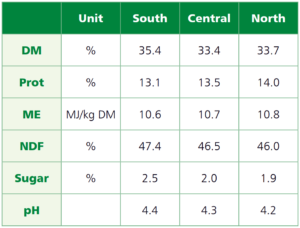Every year presents different challenges with regards to silage qualities and quantities and the 2021 growing season is no exception. A cold spring left farmers questioning whether to take an early cut with low quantity or wait and hope the rain held off and allowed the volume to grow. Overall silage quantities are healthy, with the challenge and opportunity to increase milk from forage this winter.
There are large variations between cuts and regions with regards to silage qualities, so regular analyses will be key to achieving consistently balanced diets this winter. Some key points that are consistent between the averages are summarised below:-
Dry Matter – With a grass silage dry matter average of 34.2%, a dryer silage crop should help give structure to the diet improving rumen health and butterfats. Dryer silages also allow farmers to chop silage shorter, as low as 20mm in many cases, which can help increase forage intakes and of course milk from forage. Dryer silages can cause some issues; particularly a threat to clamp stability as wild yeast cultures enjoy dry conditions when present with oxygen; so keep an eye on heating and ensure sheets are kept well sealed. Despite the dryer average, there are still many wetter crops, with some 1st cut silages analysing as low as 15% dry matter which will pose significant issues with rumen health and forage intakes. Ensure these are supplemented with some dry structural forage to slow down rumen throughput.
Protein – At an average 13.5% protein, this year’s grass silages have significantly underperformed and could cause problems with balancing diets this winter. 1st cuts actually averaged 12.5% protein which must be considered when switching silage cuts. When feeding 12kg dry matter intake of grass silage, 2021 crops will on average reduce dietary protein by 0.81% compared to 2020 crops. Whilst low protein diets are encouraged due to benefits in animal health and the environment, protein is essential for milk production, constituents and rumen bacterial growth. Effects of dietary protein being too low could be stiff dung, low milk protein, low milk yields and low peak yields, low protein diets can also result in later lactation cows dropping milk and putting on weight.
Regular silage analyses from the NWF accredited laboratory will be key in ensuring diets are balanced effectively. Low silage proteins do however give an opportunity, if we simply balance diets to achieve the same level of total dietary crude protein as last year’s silages, this will cost typically 10 pence/cow/day or an increase of 0.8kg/h/d of rapeseed meal with no extra benefit in performance. However, if 0.5kg of soyabean meal is removed and included is 1kg/h/d of Ultra Pro-R, NWF’s unique protected rapeseed meal, the cost would be the same as the previous example. However the increased supply of by-pass protein could yield an additional 1.4 litres/h/d of milk yield, particularly from early lactation cows.
Energy – An average 10.7ME across all grass silages is consistent with last years results, which shouldn’t lead to any surprises this winter, 1st cuts averaged 11.1ME where 2nd cuts averaged 10.7ME so again a variation which we have come to expect. Regionally the averages were also consistent but again, the variation within an average is significant with some silages analysing just over 9ME but many 1st and 2nd cuts recording over 12ME, so continue to test your silage to balance accordingly.
pH – Ideally grass silage pH should sit in-between 3.8 and 4.2 but this is dry matter depending. Lactic acid levels, particularly in the North are strong and VFA’s are not overly high which is all good news. Look out to heating and mold patches particularly in clamps that have not been as well compacted.
Feedback across all regions suggests silage quantities are healthy and qualities overall should enable higher intake characteristics and a potentially good milk yield from forage. The clear concern is low proteins which must be addressed. Simply increasing crude protein will increase cost with little reward, however with careful balancing, utilizing quality by-pass protein through protected protein sources like Ultra Pro-R, could enable strong milk production whilst reaping the benefit of a healthy lower protein diet.
For more advice and information on maximising your forage, get in touch with your NWF Sales Specialist.

